High-flexion tractor tyres – how they work and what they cost
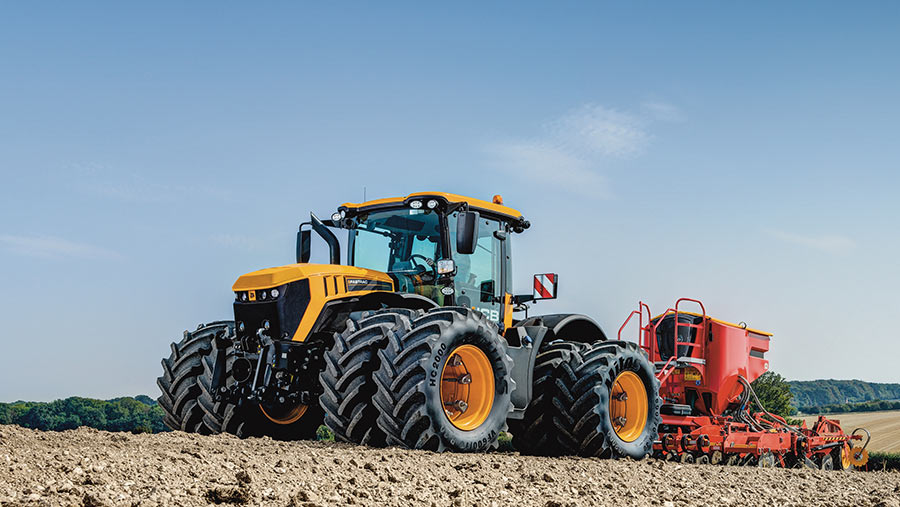 © Mitas
© Mitas Slice open one of the latest high-tech tractor tyres to compare it with a “lesser” design and, without the trained eye of a tyre engineer, you would be hard-pressed to identify much in the way of differences.
That has always been a problem with advances in agricultural tyres – tread and moulded markings aside, everything by way of improvements in materials and structures is hidden away.
See also: 10 single-pass cultivator options for heavy land
So too, to some extent, are the benefits of spending more cash on a pricier set of shoes in terms of traction, productivity, fuel saving and reduced impact on the soil and, consequently, on the crops that grow in it.
The fundamental characteristics of very high-flexion (VF) category tyres are simple enough.
Compared with a reference standard tyre of the same size, it must be capable of carrying a 40% greater load at the same inflation pressure and of carrying a given load at 40% lower inflation pressure.
That goes beyond improved-flexion (IF) category tyres, which must provide 20% performance upgrades.
In layman’s terms, it means being able to go from a standard tyre needing an inflation pressure of 1.2 bar to provide sufficient air to support a 5,760kg load to a VF tyre of the same size needing only 0.8 bar.
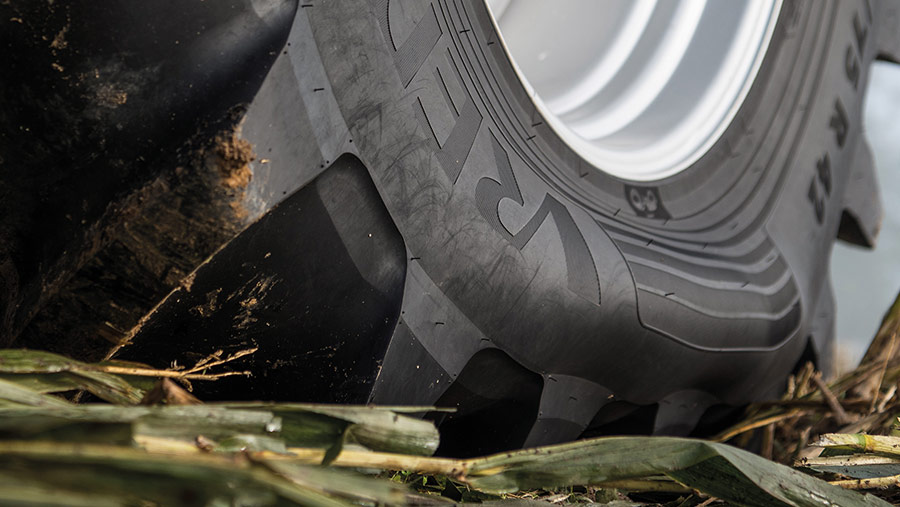
Tough yet very flexible sidewall structure enables VF tyres such as the Vredestein Traxion Optimall to operate at low inflation pressures © Vredestein
Alternatively, it may mean using tyres that can support the weight of a heavier implement and/or more ballast without having to resort to higher inflation pressures and their consequences.
Bearing in mind the general principle that it’s the volume of air in the tyre, not the tyre structure itself, that supports weight, those characteristics provide huge scope for reducing soil-compacting pressure.
Not only will they protect hard-won improvements in soil structure at depth, but also rapid rates of water infiltration at the surface after heavy rainfall.
VF category tyres achieve those characteristics through the use of materials and internal structures to create a strong and resilient sidewall with exceptional flexibility to lay down a longer and wider contact patch than less-capable tyres, while coping with repeated high levels of flexing as the wheel rotates.
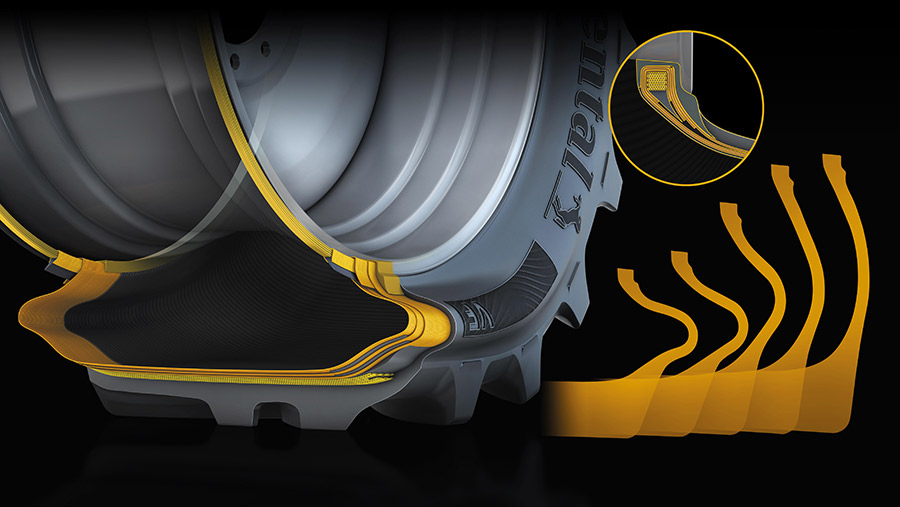
Construction of VF tyres such as the Continental VF Tractormaster focuses to a large extent on the sidewall and bead construction © Continental
Who makes what?
More manufacturers are following Michelin’s lead into the ultra-high-performance traction tyre arena by summoning the considerable technical resources and expertise needed to create tyres that meet the VF category, as defined by the European Tyre and Rim Technical Organisation.
Alliance
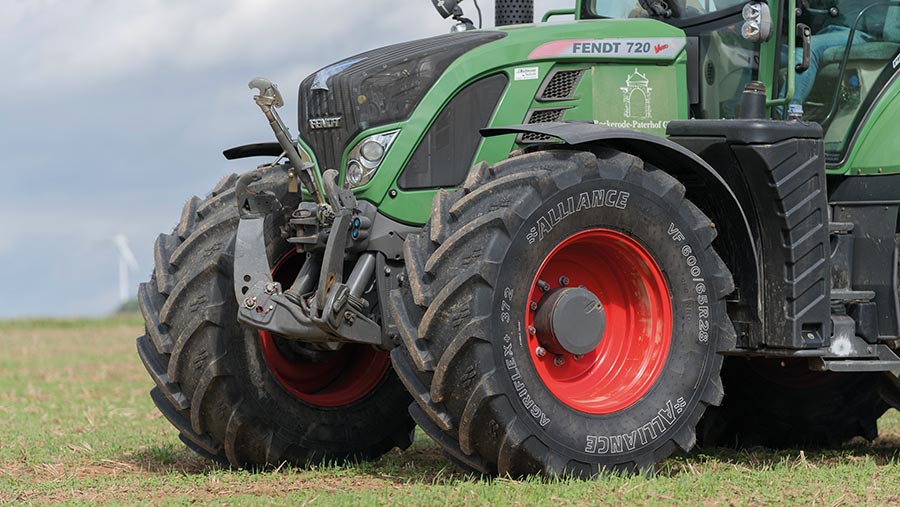
Alliance 372 Agriflex+ VF tyre © Alliance
Now part of Yokohama Rubber’s newly formed Off-Highway Tires division, Alliance Tire Group builds two VF category tyre ranges – the 365 VF Agristar in just two sizes (VF 600/65 R28 and VF 650/65 R42) and the 372 Agriflex+ with more sizes available.
The 372 Agriflex+ steel-belted design has been upgraded over the original with an improved stubble guard compound and revised tread compounds for better wear, cut and chip resistance, plus rounded lug shoulders, a larger footprint and steeper lug angles said to contribute to improved self-cleaning characteristics.
BKT
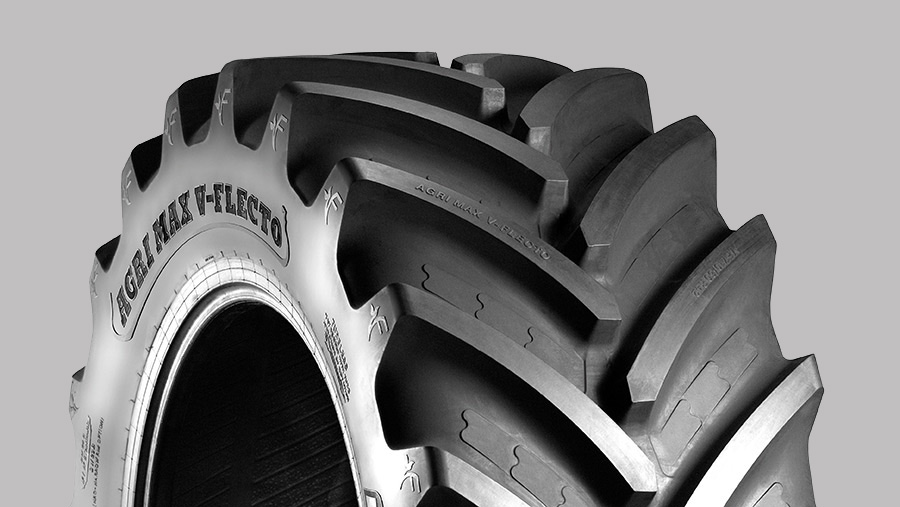
BKT Agrimax V-Flecto VF 710/60 R42 © BKT
The Agrimax V-Flecto tyre range from BKT has been further expanded with the introduction of additional sizes to suit a wider selection of tractors and power outputs.
The VF 710/70 R42, VF 750/70 R44, VF 710/75 R38 and VF 710/55 R38 join an already comprehensive line-up of 18 sizes.
These start with four widths of 28in tyres from the VF 480/60 R28 and extend to the VF 900/60 R42 for heavy tractors and the VF 750/70 R44, which only two other manufacturers build.
The majority have a “narrow rim option” designation, which allows for use on a standard rim, albeit with some operational restrictions.
Bridgestone
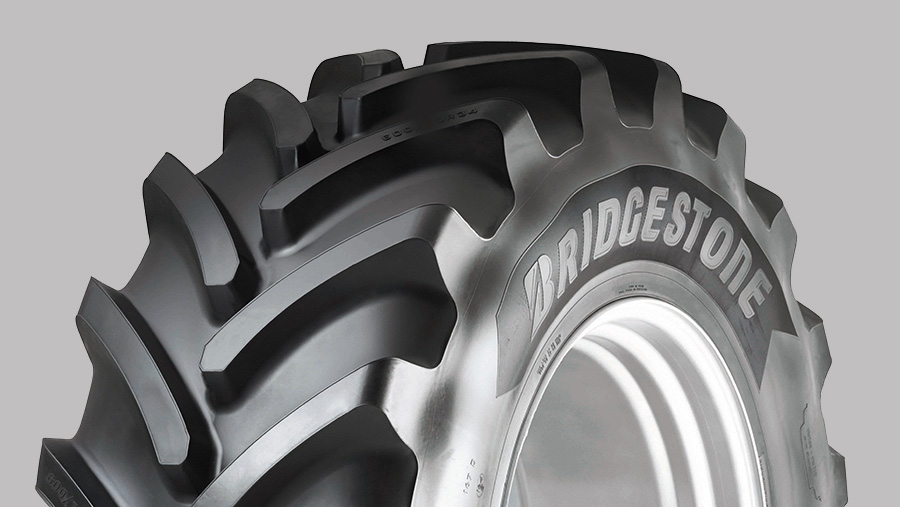
Bridgestone VT-Tractor VF 600/70 R34 © Bridgestone
As the premium brand of the Japanese manufacturer’s off-highway tyre operations – Firestone being the more familiar in agricultural circles – it makes sense for the VF category VT-Tractor tyre range to carry the Bridgestone name.
Since the European market launch in 2014, the VT-Tractor line-up has been expanded to include a comprehensive choice of sizes, with four widths each for 28in, 30in and 34in rims, and at least half-a-dozen width options for 38in and 42in rims, topping out with the VF 900/60 R42.
Bridgestone’s own comparison tests with IF category tyres of the same size showed a 26% increase in footprint, higher daily output thanks to traction gains and fuel savings of up to 36 litres over 50ha on heavy draft work.
CEAT
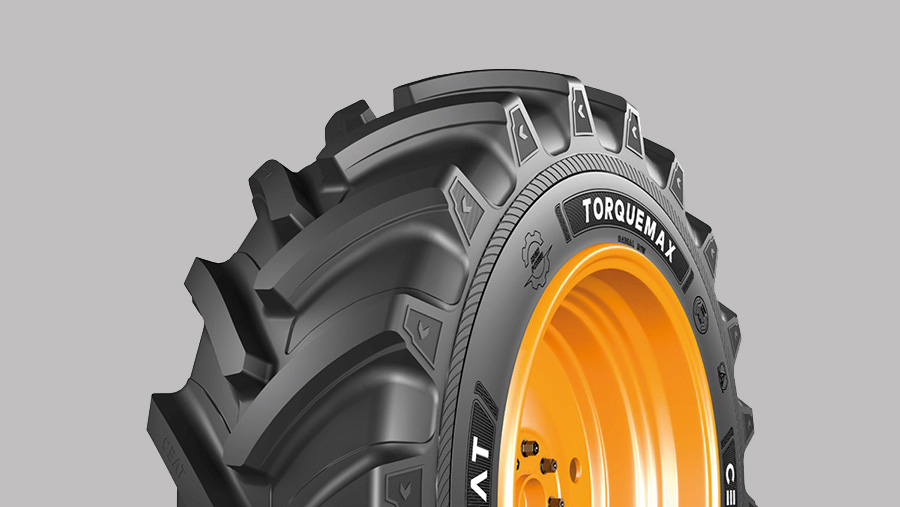
CEAT Torquemax VF 520/84 R38 © CEAT
The long-established Indian tyre manufacturer CEAT is a newcomer to the off-highway market, so while it has a number of IF tyre fitments in its Torquemax range, the Torquemax VF is currently available in just two sizes.
Both the VF 520/85 R38 and VF 710/70 R42 are rear fitments on tractors and have a moderately stepped lug as a distinctive feature of the tread design.
They also have lugs that extend prominently to the shoulders to make maximum use of the tyres’ overall width.
Continental
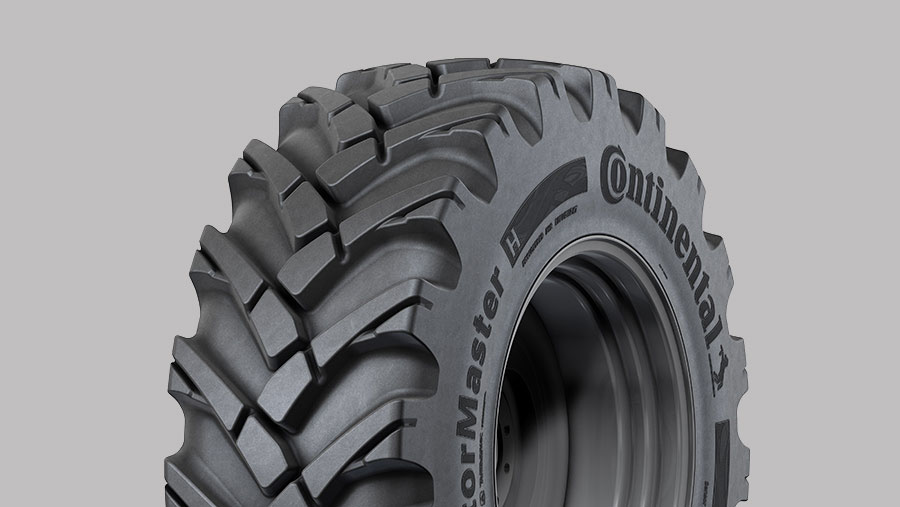
Continental VF Tractormaster Hybrid VF 710/70 R42 © Continental
Now back in the agricultural tyre market with an off-highway business based at a new factory in Portugal (its previous operations were acquired by Mitas which, in turn, was acquired by Trelleborg), Continental has been quick to catch up on the technology front.
That said, its VF Tractormaster design available since last year is produced in a limited number of sizes so far, comprising VF 600/60 R30 and VF 600/70 R30 front axle fitments and corresponding rear axle sizes of VF 710/60 R42 and VF 710/70 R42.
The design pays particular attention to the bead, which must grip the rim at the exceptionally low pressures the tyre is capable of being used at.
For the VF Tractormaster, the bead profile is larger and more flexible, with a smaller apex than on other Conti designs, and features a single reinforcing core.
The carcass uses stretchable nylon for reinforcement, which Continental says gives the tyres high levels of dimensional stability and impact strength.
A second design – the VF Tractormaster Hybrid – is a newer addition designed for tractors that clock up high road mileage as well as field work.
The tread pattern retains a traction lug layout, but in a sectional format that places more rubber towards the centre of the tyre than a regular traction tread while being more tolerant of extended high-speed journeys on the road.
A pressure sensor in each tyre allows for accurate inflation and deflation using an on-board compressor to encourage switching between field and road pressures, and temperature monitoring warns operators if the tyres are being overstretched.
Just two sizes are available for now – VF 600/70 R30 and VF 710/70 R42.
Goodyear
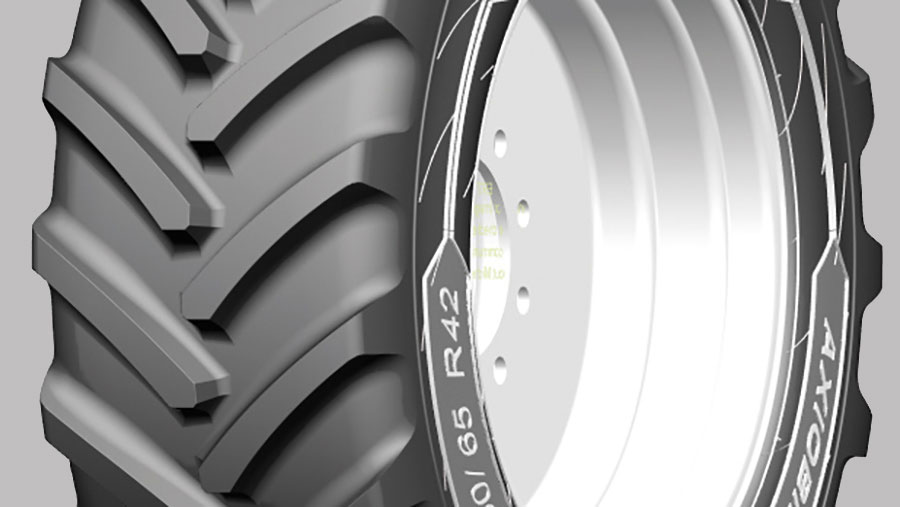
Michelin Axiobib 2 VF 650/65 R42 © Michelin
US tyre and rim manufacturer Titan International manufacturers Goodyear-branded agricultural rubbers these days and recently brought them back to the European market.
The Goodyear VF category offering is available in a number of sizes in North America, but here there are just two – the Optitrac VF 380/80 R38 and the mammoth ultra-low-profile VF 1100/45 R46, which uses Titan’s Low Sidewall technology.
Michelin
As the pioneer of both IF and VF category tractor tyres – the latter with the Xeobib – Michelin has the most experience and biggest choice of designs and sizes using the Ultraflex technology that produces a flexible but strong sidewall structure.
The Xeobib continues to be available in nine sizes, starting with a trio of 28in rims – 480, 520 and 600; a single 600mm-wide design for 30in and 34in rims; a selection of 38in tyres, and the VF 710/60 R42.
Michelin’s Axiobib 2 offers a more comprehensive line-up of 16 sizes, with better speed/load index ratings and more options to suit different tractor sizes, up to a VF 900/60 R42 and the tall VF 750/70 R44.
Michelin has also proposed a “hybrid” tyre to enable farmers and contractors undertaking a lot of road journeys to make the most of on-board inflation control systems.
The carcass is designed to present a flat aspect at field pressures for good traction and flotation characteristics but, when inflated to a pressure appropriate for extended road travel, the tyre gathers up its tread and relies more on the central row of rubber blocks to maintain lateral stability while reducing vibration.
Mitas
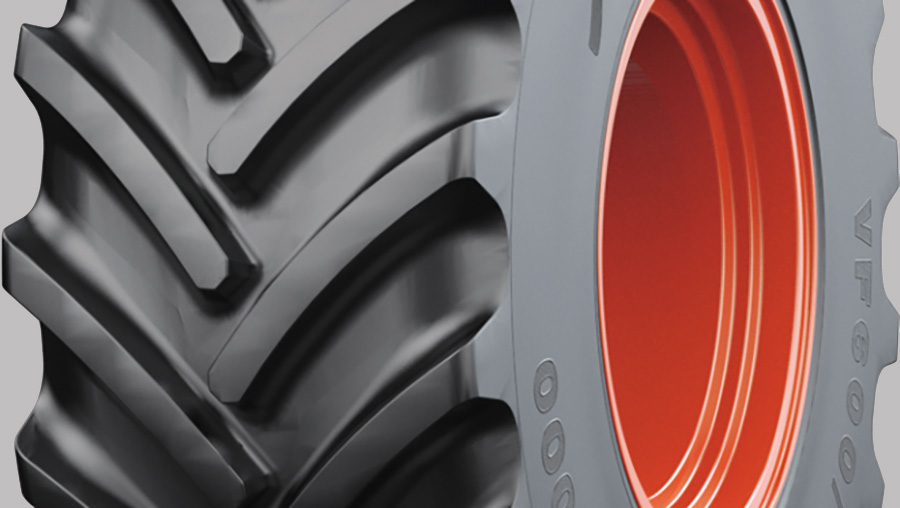
Mitas HC2000 VF 600/70 R30 © Mitas
Now a brand of the Trelleborg group, Mitas continues to maintain a large product range that encompasses a choice of VF category HC2000 tyres, starting with a front-fitment VF 420/85 R28.
For this year, two additional sizes fill out the middle ground – a VF 540/65 R34 and the larger-diameter VF 480/70 R38.
Rear axle fitments continue with three 42in sizes culminating in the VF 710/70 R42 size for big tractors.
Trelleborg
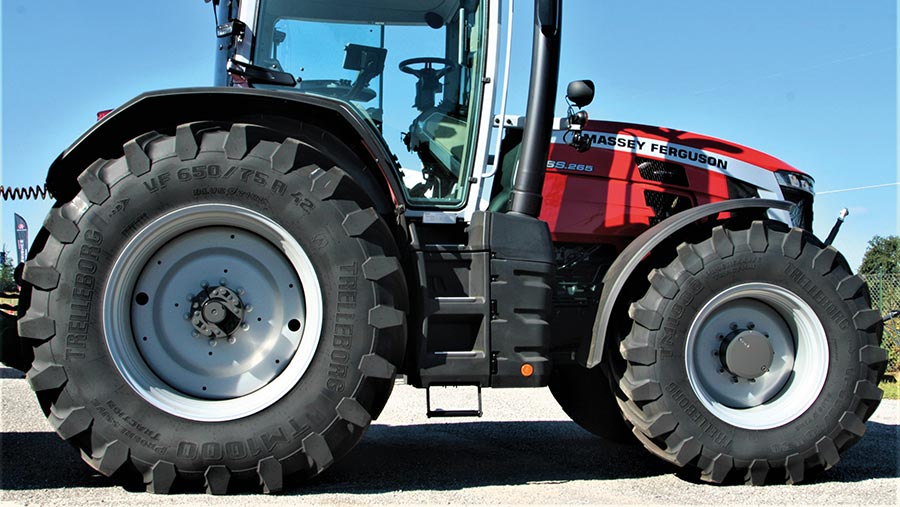
Trelleborg TM1000 with Progressive Traction tread © Trelleborg
As a manufacturer of both tyres and rims, Trelleborg is in the unique position of being able to supply complete wheel assemblies for all sizes of tractor.
On the tyre front, the TM1000 High Power design is being upgraded to VF category performance, while also getting the Progressive Traction tread lug design with its “terrace” on the leading edge.
This feature performs several functions – it anchors the lug structure more effectively to reduce bending and the subsequent “flick” that occurs when the tractive load comes off the lug, which reduces wear and vibration.
It also enhances the self-cleaning properties of the tyres, says Trelleborg, while improving traction by increasing the surface area of the face of a lug without having a negative effect on penetration into the soil.
As a consequence, the tyre’s development engineers found that compared with a regular lug structure, the Progressive Traction design increased grip by up to 10%, reduced fuel consumption by 3%, and extended tyre life by as much as 5%.
A dozen TM1000 Progressive Traction tyre sizes are planned from VF 600/70 R30 to VF 710/75 R42, with a number of other dimensions covered by the TM1060 VF design, which currently retains the traditional Trelleborg tread pattern.
Vredestein
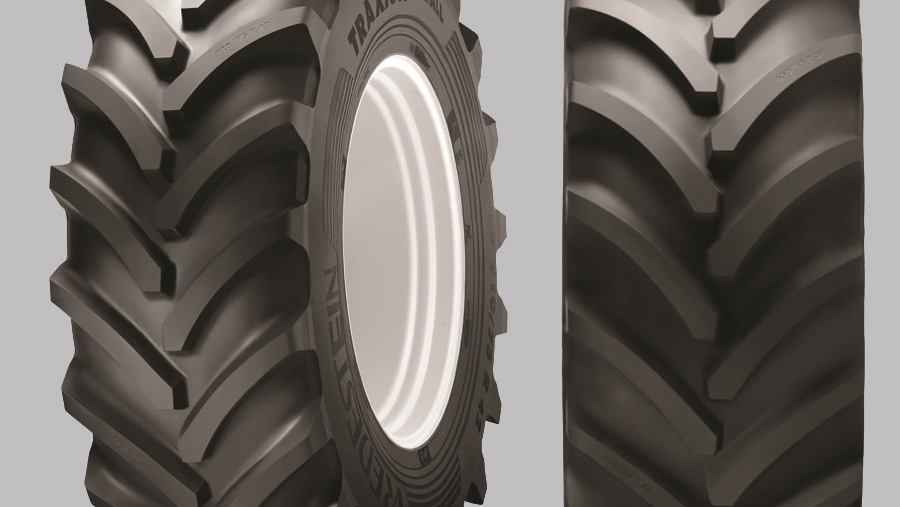
Vredestein Traxion Optimall VF 710/75 R42 © Vredestein
Apollo Vredestein has expanded its range of Traxion Optimall VF performance tyres with three sizes that particularly suit growers who run an in-furrow plough.
The VF 650/85 R38 and VF 650/85 R42 are narrow enough to fit into the furrow bottom, while the 85% aspect ratio – the depth of the sidewall relative to the width – provides the air volume for high load capacity and low-inflation pressures.
These two are accompanied by a new VF 600/70 R34 front-axle tyre that extends the choice of 30in and 34in sizes to half-a-dozen options.
These complement a similar number of 38in and 42in rear-axle fitments that culminate in the VF 900/60 R42.
All feature Vredestein’s trademark lug design, which places more rubber down the centre for reduced vibration and more wear resistance on tractors doing a lot of road work, while still generating high traction levels in the field.
VF category tractor tyres |
|
| VF 620/70 R26 | Alliance 372 Agriflex+ |
| VF 420/85 R28 | Mitas HC2000 |
| VF 480/65 R28 | Bridgestone VT-Tractor |
| VF 480/60 R28 | BKT Agrimax V-Flecto, Michelin XeoBib |
| VF 520/60 R28 | BKT Agrimax V-Flecto, Michelin XeoBib, Trelleborg TM1060 |
| VF 540/65 R28 | BKT Agrimax V-Flecto, Bridgestone VT-Tractor |
| VF 600/70 R28 | Alliance 372 Agriflex+, Bridgestone VT-Tractor |
| VF 600/65 R28 | Alliance 365 VF Agristar, Bridgestone VT-Tractor |
| VF 600/60 R28 | Alliance 372 Agriflex+, BKT Agrimax V-Flecto, Michelin XeoBib, Trelleborg TM1060 |
| VF 520/60 R30 | BKT Agrimax V-Flecto |
| VF 540/65 R30 | Michelin AxioBib 2, Mitas HC2000 |
| VF 600/70 R30 | Alliance 372 Agriflex+, BKT Agrimax V-Flecto, Bridgestone VT-Tractor, Continental VF TractorMaster, Continental VF TractorMaster Hybrid, Michelin AxioBib, Michelin EvoBib, Mitas HC2000, Trelleborg TM1000 Progressive Traction, Vredestein Traxion Optimall |
| VF 600/60 R30 | Alliance 372 Agriflex+, BKT Agrimax V-Flecto, Continental VF TractorMaster, Michelin AxioBib, Michelin XeoBib, Trelleborg TM1060 |
| VF 620/75 R30 | Michelin AxioBib 2, Vredestein Traxion Optimall |
| VF 620/70 R30 | Bridgestone VT-Tractor |
| VF 650/75 R30 | Alliance 372 Agriflex+ |
| VF 710/60 R30 | Bridgestone VT-Tractor |
| VF 710/55 R30 | Bridgestone VT-Tractor |
| VF 380/85 R34 | Mitas HC2000 |
| VF 420/85 R34 | Mitas HC2000, Trelleborg TM1000 Progressive Traction |
| VF 650/65 R34 | Michelin AxioBib 2, Vredestein Traxion Optimall |
| VF 650/60 R34 | Michelin AxioBib 2, Trelleborg TM1000 Progressive Traction, Vredestein Traxion Optimall |
| VF 600/65 R34 | Bridgestone VT-Tractor |
| VF 600/60 R34 | Michelin XeoBib |
| VF 710/60 R34 | Bridgestone VT-Tractor, Michelin AxioBib 2, Vredestein Traxion Optimall |
| VF 380/95 R38 | Mitas HC2000 |
| VF 380/80 R38 | Goodyear Optitrac |
| VF 480/70 R38 | Mitas HC2000 |
| VF 520/85 R38 | CEAT Torquemaster |
| VF 540/65 R38 | BKT Agrimax V-Flecto |
| VF 600/65 R38 | Bridgestone VT-Tractor |
| VF 600/60 R38 | BKT Agrimax V-Flecto, Michelin XeoBib |
| VF 650/85 R38 | Bridgestone VT-Tractor, Michelin AxioBib 2, Vredestein Traxion Optimall |
| VF 650/65 R38 | BKT Agrimax V-Flecto, Bridgestone VT-Tractor, Mitas HC1000 |
| VF 650/60 R38 | BKT Agrimax V-Flecto, Michelin XeoBib, Michelin AxioBib 2, Trelleborg TM1060 |
| VF 710/75 R38 | BKT Agrimax V-Flecto |
| VF 710/70 R38 | BKT Agrimax V-Flecto, Bridgestone VT-Tractor |
| VF 710/60 R38 | BKT Agrimax V-Flecto, Michelin XeoBib, Trelleborg TM1060 |
| VF 800/70 R38 | Bridgestone VT-Tractor, Michelin AxioBib 2, Trelleborg TM1000 Progressive Traction, Vredestein Traxion Optimall |
| VF 900/60 R38 | Bridgestone VT-Tractor |
| VF 520/85 R42 | Mitas HC2000 |
| VF 580/85 R42 | BKT Agrimax V-Flecto |
| VF 620/70 R42 | Bridgestone VT-Tractor |
| VF 650/85 R42 | Vredestein Traxion Optimall |
| VF 650/75 R42 | Trelleborg TM1000 Progressive Traction |
| VF 650/65 R42 | Alliance 365 VF Agristar, BKT Agrimax V-Flecto, Bridgestone VT-Tractor, Michelin AxioBib 2, Mitas HC2000 |
| VF 650/60 R42 | – |
| VF 710/75 R42 | Bridgestone VT-Tractor, Michelin AxioBib 2, Vredestein Traxion Optimall |
| VF 710/70 R42 | BKT Agrimax V-Flecto, Bridgestone VT-Tractor, CEAT Torquemaster, Continental VF TractorMaster, Continental VF TractorMaster Hybrid, Michelin AxioBib 2, Michelin EvoBib, Mitas HC2000, Trelleborg TM1000 Progressive Traction, Vredestein Traxion Optimall |
| VF 710/60 R42 | Alliance 372 Agriflex+, BKT Agrimax V-Flecto, Continental VF TractorMaster, Michelin AxioBib, Michelin XeoBib, Trelleborg TM1060 |
| VF 800/70 R42 | Vredestein Traxion Optimall |
| VF 900/60 R42 | BKT Agrimax V-Flecto, Bridgestone VT-Tractor, Michelin AxioBib 2, Vredestein Traxion Optimall |
| VF 900/50 R42 | Bridgestone VT-Tractor |
| VF 750/70 R44 | BKT Agrimax V-Flecto, Michelin AxioBib 2, Trelleborg TM1060 |
| VF 750/60 R46 | Mitas HC1000 |
| VF 1100/45 R46 | Goodyear Optitrac LSW |
| Note: Check with distributors for current production and availability status | |
Tyres in trials
In field tests carried out by the INRAE food, agriculture and environment institute in France, the Alliance 372 Agriflex+ VF 600/70 R30 (front) and VF 710/70 R42 (rear) sizes were compared with a premium brand VF equivalent across a series of tests, as well as Alliance and competitor IF tyres of the same size.
The results confirmed the superior performance VF tyres offer over IF designs; using the Alliance IF tyres as the control, the 372 Agriflex+ delivered a 10% larger footprint – just 2% behind the equivalent competitor – and 25% greater traction, just 3% behind the premium offering.
On fuel efficiency, the 372 Agriflex+ matched the competitor VF tyre combination while recording 7% lower fuel consumption than the tractor equipped with IF tyres.
These underscore the gains to be made from exploiting tyres with VF technology, says Alliance.

Alliance 372 Agriflex+ VF 600/65 R28 © Alliance
How much do they cost?
Ultra-high-performance VF category tyres are now a common feature of most tractor manufacturers’ price lists, as more growers are prepared to invest in equipment that exploits the machine’s performance potential to the full.
In some cases, new tyres and new tractors are developed in parallel; the 205-285hp Massey Ferguson 8S tractors, for example, have been launched exclusively with a unique VF 650/75 R42 tyre size option produced by Trelleborg for its TM1000 Progressive Traction range.
Claas
At Claas, the optional IF 710/75 R42 tyres for Axion 900 tractors are being phased out in favour of the more capable Michelin VF Axiobib 2s tyres as a £1,470 option. Larger VF alternatives include a Trelleborg TM1060 combination comprising VF 750/70 R44 and 650/60 R38 tyres at £1,865 as a substitute for the standard fitment.
If an in-furrow ploughing option is needed, a set of Michelin Axiobib 2 VF 650/85 R42 rears at £2,915 can be had in combination with IF 650/65 R34 fronts from the Trelleborg TM1000 High Power range at £2,335.
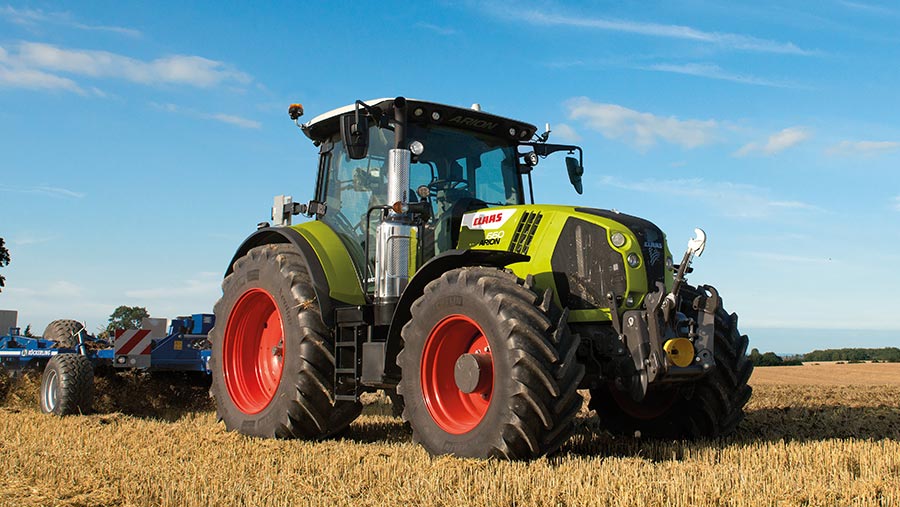
Claas Arion 500 and 600 tractors come on Mitas or Firestone 520/85 R38 and 420/85 R28 regular tyres as standard © Claas
With the exception of the 4200 S-Trac model, the Claas Xerion comes on 710/75 R42 Trelleborg TM900 tyres all round; an upgrade to the Vredestein Opitmall VF 900/60 R42 can be had at £4,405 while the same size Axiobib 2 tyres are a £13,990 alternative.
Further down the power and performance scale, Arion 430 and upwards tractors equipped with Mitas 420/85 R38 rears and 380/85 R28 fronts can have a Michelin Xeobib VF 600/60 R38 and 480/60 R28 combination for an extra £4,440.
New Holland
Check out the New Holland options list and several size and technology upgrades are available for the T7 range, including a VF 710/60 R42 plus VF 600/60 R30 combination for a long-wheelbase model at £4,145 on adjustable rims or a little less with fixed rims.
On the T7 Heavy Duty tractors, swapping a set of regular Michelin 710/70 R42 and 600/70 R30 tyres for same-size VF alternatives adds £4,211 to the list price.
Deutz-Fahr
Where more than one make of a particular tyre size is available, it is common to see a surcharge levied if the customer wants a particular brand to reflect the logistical implications of that choice.
A Deutz-Fahr 6130, for example, comes as standard on Mitas or BKT 480/70 R24 and 520/70 R34s, which can be upgraded to VF 520/60 R28 and VF 650/60 R38s for £2,813; unless the buyer specifies the Michelin Axiobib 2 or Trelleborg TM1000 on offer, in which case a named brand surcharge of £1,893 applies.
JCB
Selecting a combination of tyres for a JCB Fastrac 4000-series is simpler, thanks to having the same size wheels front and rear. With the Stage 5 version introduced last year came new VF options to give a tractive and flotation performance lift.
These include 30in and 34in Mitas HC 2000, and 30in and 40in Michelin Axiobib 2 tyres. The selection for the larger Fastrac 8000 with 38in front and 42in rear rims extends to the BKT V-Flecto, Trelleborg TM1060 and Mitas HC2000.
Case-IH
Case-IH offers a generous choice of tyres sizes and technologies, especially as the size and power outputs of its tractors increase.
A 135/155hp Maxxum 125 comes on 380/85 R28 and 460/85 R38 tyres from the Michelin Agribib, Trelleborg TM600, Firestone Performer85 and Mitas AC85 ranges, with surcharges from £403 (Firestone) to £1,529 (Trelleborg) applicable if one of those is specified.
Upgrade options include Michelin Xeobib or Trelleborg TM1060 in sizes VF 520/60 R28 and VF 650/60 R38 at £3,645.
Unless bigger, more advanced tyres are ordered, a 180/210hp Puma 165 CVX is delivered on regular 540/65 R28 and 650/65 R38 tyres, which could be Michelin Multibib, Trelleborg TM800, Firestone Performer65 fronts with Maxitraction 65 rears, or a Mitas AC65 and SST combination.
For increased flotation and traction, the VF option is for a set Michelin Axiobib 2 VF 540/65 R30 and VF 650/65 R42 at £4,303.
Further up the scale, a Magnum 380 CVX with 417/435hp on tap will have a Trelleborg, Michelin, Mitas, Firestone or Goodyear combination of 600/70 R30 tyres up front and 710/70 R42 rears.
Sticking to the same size, but gaining 40% more load capacity (or up to 40% lower inflation pressures) comes with ticking the VF option box for a set of Michelins at £4,336.
Alternatively, go large with VF 900/60 R42 rears and VF 650/60 R34 fronts and the bill increases to £8,252.
Fendt
A glance at the Fendt price list shows that the 415hp 942 Vario is given a set of Trelleborg TM1060 VF tyres as standard to make the most of its performance potential, with alternatives to the VF 650/60 R38 and VF 750/70 R44 combination being higher-load-capacity versions or narrower sizes.
Similarly, buyers of Fendt’s 517hp 1050 Vario can only go smaller from the standard tyres, which are an IF category more able to cope with the level of grip and torque generated at this size.
But lower down the range there are plenty of high-performance VF options on offer.
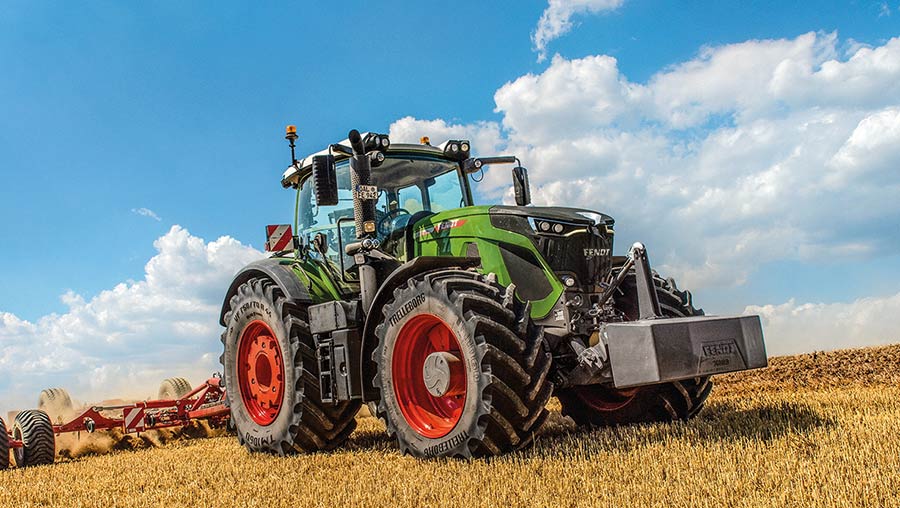
Latest-generation Fendt 942 Vario is fitted as standard with a VF 750/70 R44 rear, VF 650/60 R38 front combination – in this case provided by the Trelleborg TM1060 © Fendt
On the 287hp 828 Vario, for example, the regular 540/65 R30 and 650/65 R42 Mitas AC65 tyres fitted as standard can be swapped out for VF 600/70 R30 and VF 710/70 R42 Michelin Axiobib 2s at a cost of £10,830 to make a significant gain in both tyre scale and sophistication.
Trelleborg TM800 tyres are fitted to the 246hp 724 Vario in standard form, but an extra £7,358 on the purchase price brings VF 600/60 R30s on the front axle and VF 710/60 R42s at the back from the Axiobib 2 range again.
A similar upgrade for the 150hp 714 Vario amounts to £3,602, albeit involving Xeobib tyres on 28in and 38in rims.
Prices to replace worn standard tyres with a VF set are best quoted by specialist suppliers on a case-by-case basis, as this will often require new rims to meet the particular dimensions required.
Tyre pressure management pays dividends
Differences between pressure settings may look small, but slight variations can make a big change to the resulting contact patch of very supple tyres such as the new VF designs.
So, it is surely worth taking the trouble to make adjustments when tractors change from one task to another for a length of time.
Switching from grain haulage at harvest to autumn cultivation is a case in point; likewise, from autumn ploughing to spring top work.
Both situations involve substantially different operating speeds, as well as torque and weight loadings on the tyres.
As Stephen Mills, technology manager at Lincolnshire dealer group Peacock & Binnington, points out: “Overinflation limits sidewall flexibility, so you get a smaller footprint, resulting in less grip and greater soil compaction.
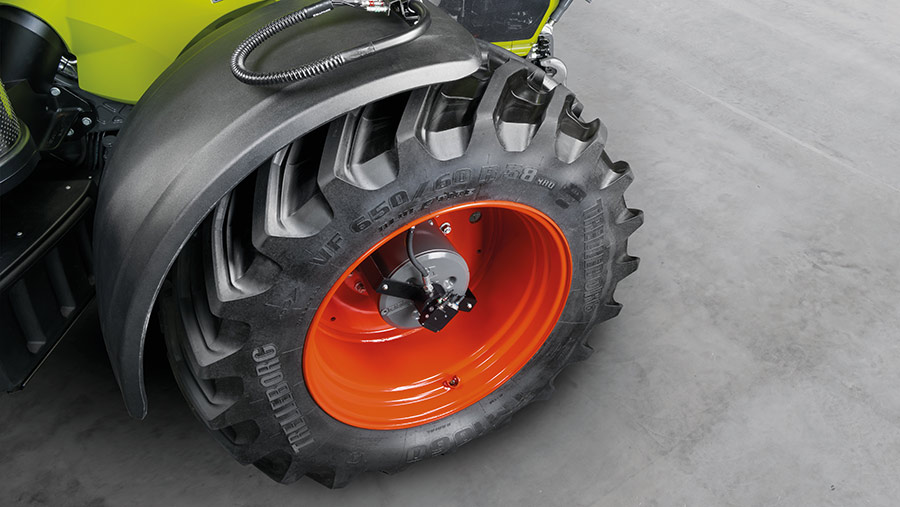
VF category tyres are especially well suit to tractors with on-board tyre management systems © Trelleborg
“Increased levels of tyre wear result from the lower traction, and you use more fuel because of the lower work rate,” he adds.
“As a general rule of thumb, 20% overinflation can result in a 30% performance loss, and with the low pressures we use today, 20% can be as little as 0.16 bar or 2.4psi.”
The ideal way to determine the appropriate inflation pressure for different operations is to weigh the tractor with different implements, using either a weighbridge one axle at a time or calling in a manufacturer’s technical adviser, who will use portable weigh cells.
Just remember to weigh each axle in the “worst-case” configuration – with rear-mounted equipment this is with the implement up in the air for the rear tyres and down on the ground for the front tyres – to reflect the maximum weights the tyres will bear in operation.
Divide the results by two to get the weight per tyre, and then refer to the manufacturer’s data table for the tyre model and size to see the recommended inflation pressure, adding 0.5 bar for situations such as working across hilly ground, which will impose added load and sidewall stress.
In the absence of weighing facilities, the online calculators and smartphone apps developed by tyre suppliers provide useful guidance, as long as reliable implement weights are entered to enable the algorithms to account for the overhang effect of mounted equipment.
An illustration of the impact on soils of tyre choice and inflation pressure management – in this case on water infiltration rate in wheelings:
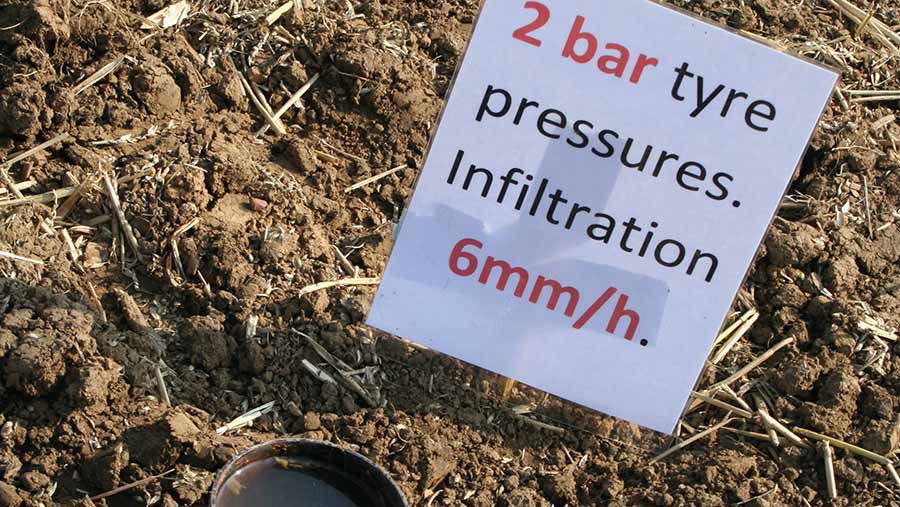
© Peter Hill
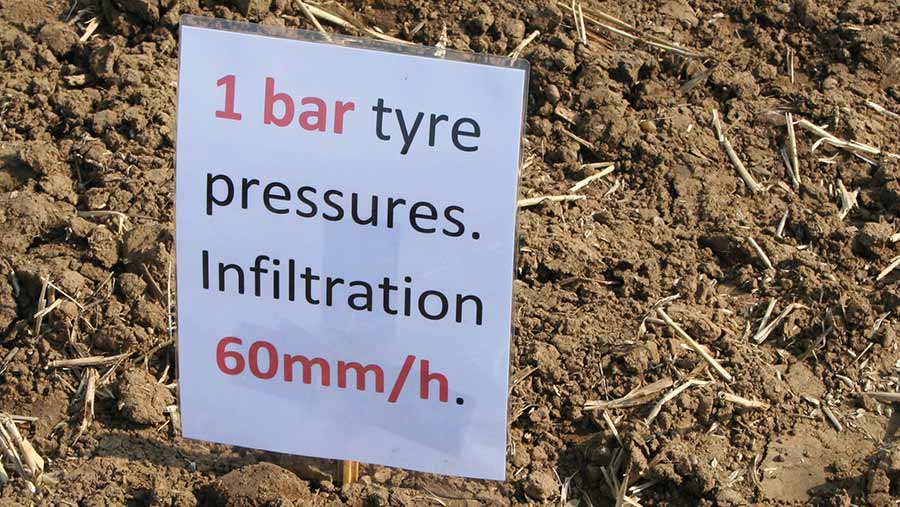
© Peter Hill
Not just for tractors
As well as becoming mainstays on tractors, the load-carrying capabilities of VF tyres can also be exploited on large self-propelled sprayers.
Flawborough Farms in Nottinghamshire switched a Horsch Leeb 8.300 PT to a set of Michelin Axiobib 2 VF 650/85 R42 tyres to carry the weight while also providing good flotation.
“The Axiobib 2 is the biggest tyre we can have without going too crazily wide for the road or for the crop in the field,” explains grower Tom Hawthorne.
“We do have to move to a narrow row-crop wheel eventually, but we keep this tyre on as late into the spring as possible.
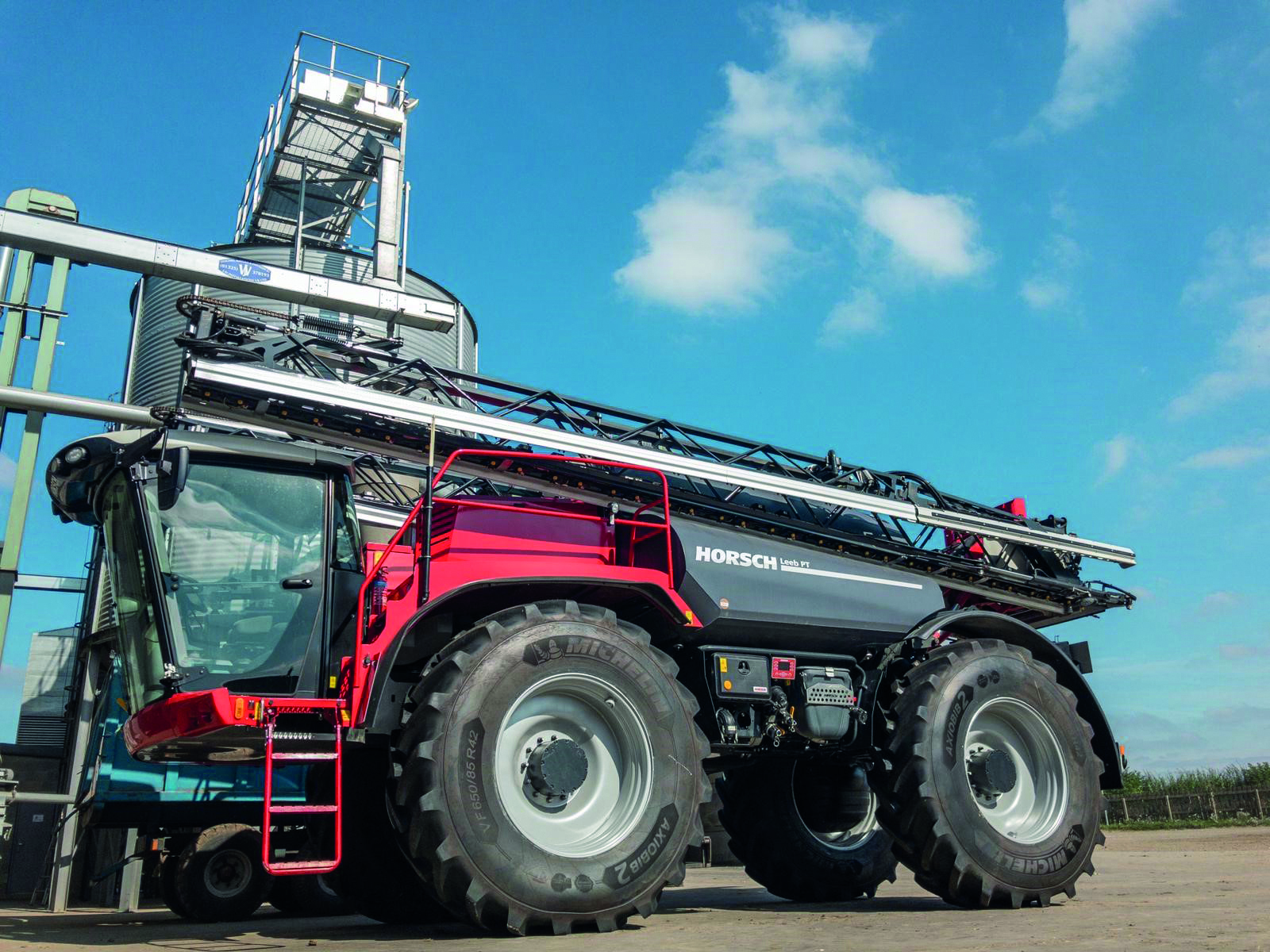
Flawborough Farms is getting the best from its Horsch sprayer after switching the original equipment fitments for a set of Michelin AxioBib 2 tyres © Horsch
“Because they are so tall, the Axiobibs give me the clearance I need when spraying and they can carry heavy weights at very low pressures, while the speeds they give me are as good as you can get.”

